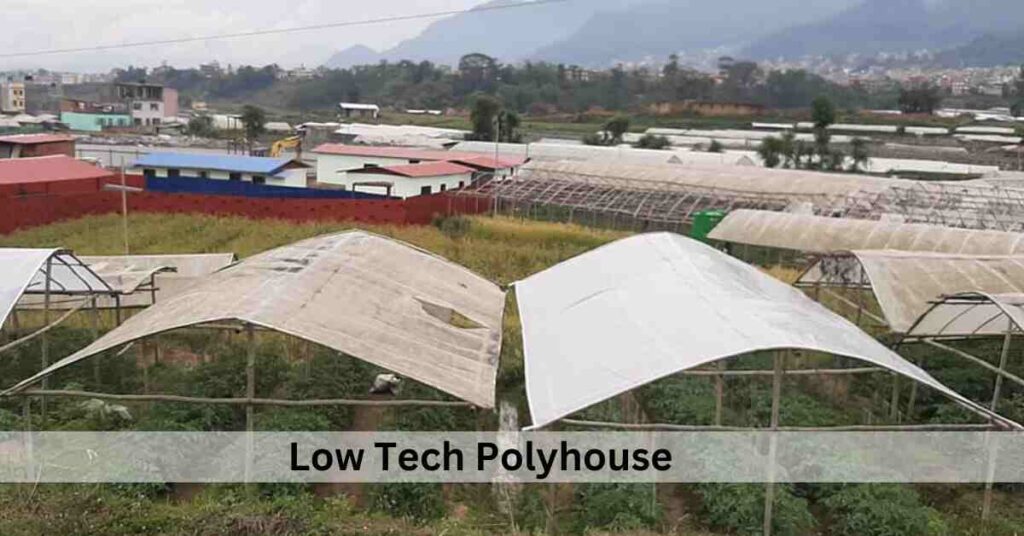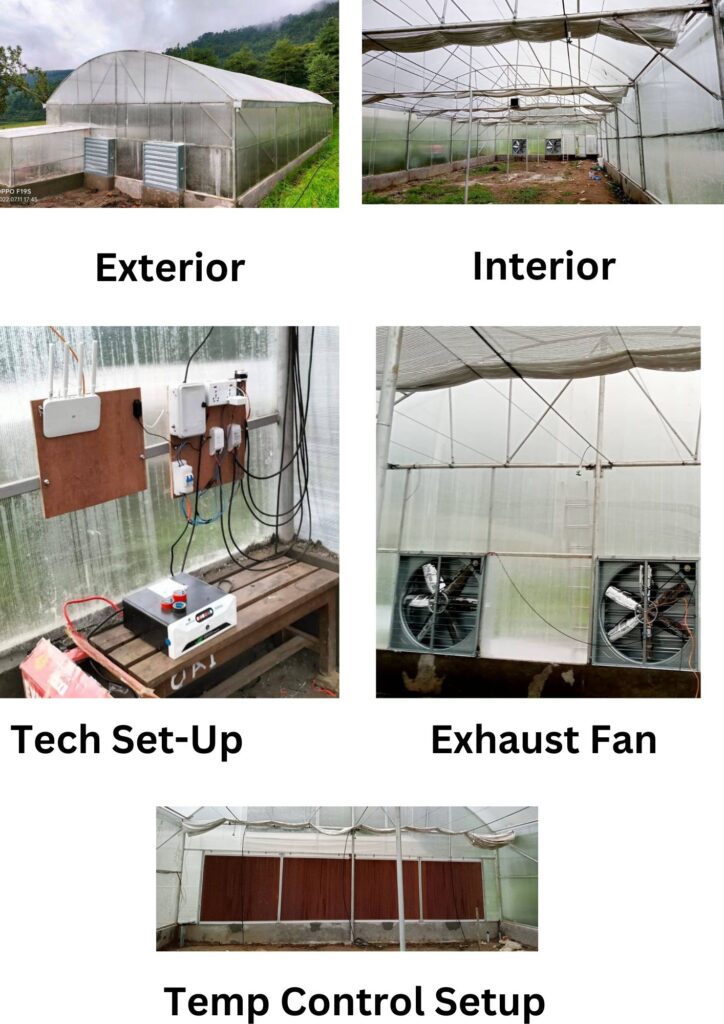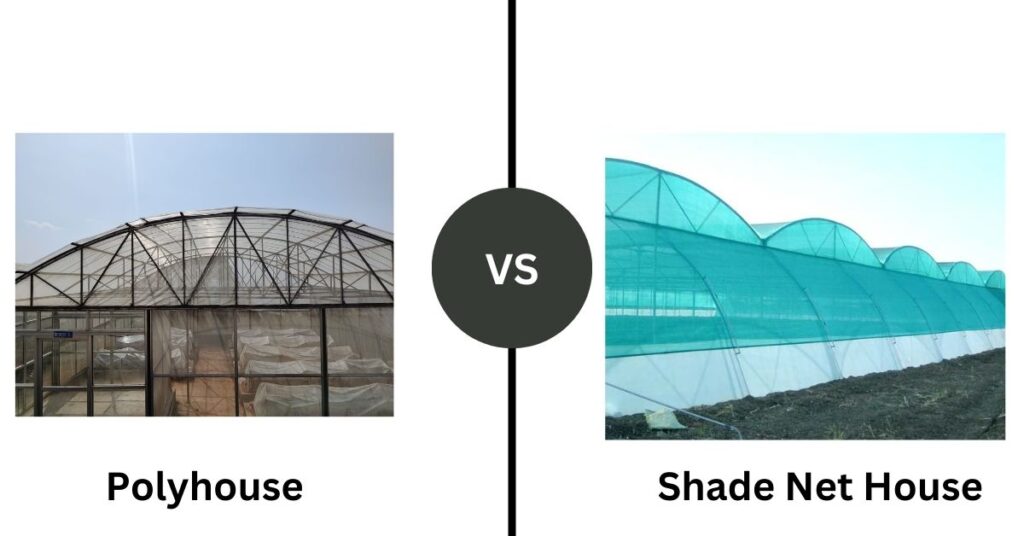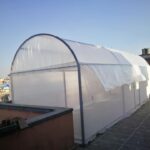Introduction
A specialised structure which uses controlled climatic conditions to grow different types of crops is called a polyhouse. It is a structure in which transparent polyethylene is used as a cover, under which different crops are grown. Different shapes can be employed to make polyhouse structures such as square, semi-circular, rectangular or lengthened.
To achieve the controlled micro-environment inside the polyhouse, different types of automated devices are used which jointly work to maintain the temperature, humidity and ventilation at an ideal condition for a specific crop.
In short, Polyhouse farming is the practice of growing crops under a controlled environment. It is a newly evolved technology and is proven beneficial for growing several types of crops and maintaining them easily. The temperature and humidity can be controlled as per our requirement. This technology protects the plants against changing weather conditions. Each and every factor affecting the crop can be controlled inside the polyhouse no matter what the external climatic conditions prevails. So, This technology facilitates the year round production of crops. As it protects the crops from climatic adversity, it helps to take more yield even in this present status of climate change. Due to its manifold advantages over other farming, polyhouse farming is gaining popularity across the world. In a polyhouse, a thin plastic sheet is used to cover the structure that separates the internal environment from outside.
Is it a Greenhouse?
Both greenhouse and polyhouse are used to create controlled environments and both are similar in appearance. However, there is a difference between them. The difference lies in the use of covering material. In greenhouse wood, glass, polyethylene etc are used as covering materials whereas in polyhouse specifically and only the polyethylene is used to cover the structure. Polyhouse structures are relatively cheaper than a greenhouse. Polyhouse farming is much popular in developing countries due to its relatively low maintenance cost. Also, a polyhouse is the miniature form of a greenhouse. So, it is popular for small-scale commercial farming.
Also Read: Distinguish Between Subsistence Farming And Intensive Farming
History of Polyhouse in the World
The concept of the greenhouse was started during the 1st century A.D. At that time, the ruling king Tiberius Caesar was advised by his physician to eat one cucumber a day. This necessitates the use of certain types of structure to facilitate the year production of cucumber. During the 16-17th century the concept of glasshouse was developed. However, the concept of polyhouse was developed after world war II after the development of polyethylene. At first, polyhouse as a controlled structure was used at the University of Kentucky in 1948.
Types Of Polyhouse
Based on environmental controlling system, polyhouse is classified into following categories:
1. Naturally Controlled Polyhouse
In naturally controlled polyhouse, no automated devices are used. In order to avoid bad climates, adequate ventilation is maintained. It is a low cost technology as it is constructed by using the locally available materials. Generally, timber and bamboo are used for constructing this type of polyhouse. The initial investment is low for this type of polyhouse. They are most suitable for hilly regions. This type of polyhouse protects the crops from climatic adversity and pest attack.
2. Manually controlled polyhouse
Automated devices are used to control temperature, humidity and light. This type of polyhouse is used for producing off-season crops.
On the basis technology used, polyhouse is classified into following categories:
1. Low-tech Polyhouse

In low-tech polyhouse no automated devices are used. In this type of polyhouse, ultraviolet film is used as the coating material which protects the plants from the cold. Also, temperature and humidity are controlled as per requirement. Since this is based on local constructing material, it is a cheaper technology. This technology also uses locally available materials like timber, bamboo etc. Also, in this technology shade nets can be used for controlling light intensity.
2. Medium-tech polyhouse

In medium-tech polyhouse, galvanised iron pipes(GI Pipes) are used for creating the structure. Screws are attached to the structure for the canopy cover. For humidity and temperature control, cooling pads are used. Also, thermostat, exhaust fans are also used to control the internal conditions. This type of polyhouse uses automated devices for controlling temperature, humidity, light and other parameters. This technology facilitates the off-season production of agricultural commodities.
3. High-tech polyhouse
Highly sophisticated technologies are used for controlling the internal environment. This technology is proven best for off-season production of agricultural commodities. However, this is a costlier technology than the previous two.
What Happens Inside the Polyhouse?
Carbon dioxide is vital for plants. Higher the level of CO2, higher will be the photosynthesis. Polyhouse helps to increase CO2 concentration. In an open environment, the level of CO2 is 350 t0 400 ppm whereas it reaches to 1200 to 1500 ppm in a polyhouse. This accumulated CO2 is used for photosynthesis during the day time. Polyhouse filters the excess sunlight and it allows fifty to sixty percent sunlight to enter the polyhouse. So, it also protects the crop from scorching. This way, Polyhouse farming leads to greater profit.
Polyhouse Farming
Polyhouse farming is a practice of cultivating crops in a controlled environment created under a structure covered by thin plastic sheets. Generally, galvanised iron pipes are used for creating structure which is covered by polyethylene sheets. Different types of automated devices are used for controlling temperature, humidity and light intensity. Polyhouse farming facilitates production of crops year round while ensuring a higher net return.
Polyhouse vs Shade Net

Shade net protects plants from sunlight whereas polyhouse is used to create controlled environments. Shade nets are suitable for light sensitive plants.
Crops Suitable In Polyhouse
Diverse group of crops can be grown under a polyhouse. Here, we have listed major crops grown in polyhouse farming.
A. Vegetables
| Cucumber |
| Carrots |
| Tomatoes |
| Brinjal |
| Chilli |
| Spinach |
| Capsicum |
| Okra |
| Cabbage |
| Lettuce |
| Leafy vegetables |
| Bitter gourd |
| Summer squash |
B. Flowers
| Rose |
| Gerbera |
C. Fruits
| Watermelon |
| Strawberries |
| Peaches |
| Citrus fruits |
| Raspberries |
Materials Needed for Polyhouse
Different materials are used for constructing the polyhouse. The following materials and accessories are used in the construction of polyhouses:
1. GI Pipes or Bamboo
GI pipes otherwise known as galvanised iron pipes are the foundation pipes for polyhouse. They are usually 3 mm thick. However, low-tech polyhouse use bamboo logs for creating structures.
2. Silpaulin PLastic
3. Nets
4. Drip Pipes
5. Mulching Plastic
6. Self-drilling screws
They are used to fix the full length of the profile at every 40 cm.
7. Zig zag spring
They are used to fix the polyhouse materials together.
8. Angle Brackets
Angle brackets are used to fix polyhouse structures. Two types of angle brackets are used in polyhouse, Polyhouse L Brackets and Polyhouse F Bracket.
9. Polyhouse half clamp
This type of clamp connects two purlin pipes (longitudinal structural membrane of a roof) in a polyhouse.
10. Polyhouse full clamps
They connect column pipes to hockey pipes as per polyhouse requirement.
11. Polyhouse curtain clamp
It holds the curtain together.
12. Polyhouse universal joint
They are used to move curtain sides up and down.
13. Polyhouse GI Gutter sheet
It is useful for drainage systems.
14. Polyhouse net pulley
They are used for sliding the shade nets in order to increase or decrease the crop shade.
15. Trellising Accessories
Trellising Accessories are used to keep fruits and vegetables away from the ground in order to avoid the attack from pests and diseases. Nylon and synthetic ropes along with clips are used to hold the plants.
16. Plant supporting Thread
They are used to tie polyhouse plants and vines.
Construction Of Polyhouse
- At first a right location should be selected.
- Then as per your requirement, determine the size of the polyhouse and then determine the appropriate design.
- Afterwards, build your polyhouse. First, create the foundation structure and then cover it with the polyethylene.
- Then install the required sophisticated device for controlling temperature and humidity.
Economic Cost Analysis Of Polyhouse
Cost required for establishing a polyhouse structure varies according to the technology used in it. Naturally controlled polyhouse require relatively low cost as compared to controlled polyhouse. Similarly, low-tech polyhouse are relatively cheaper than medium and high-tech technology. For the cost analysis first we have to know about the requirement. The following materials are required while establishing the polyhouse:
- Land
- Polyethylene sheet
- Irrigation material
- Galvanised iron pipes, bamboo or timber
- Automated devices for controlling temperature, humidity, light intensity
Based on our review of different research articles and surveys with farmers, we found that the following is the cost of poly houses per acre in India:
| Types of Polyhouse | Low Tech Polyhouse | Medium Tech Polyhouse | High Tech Polyhouse |
| Cost Per Acre(INR) | Under 100,000 | 200,000-300,000 | More Than 300,0000 |
Advantages
- The environment can be administered as per the crop requirement.
- It facilitates the year round production of agriculture commodities.
- Better protection against diseases, pests and insects.
- Polyhouse farming protects the plant from climatic adversity.
- It ensures the production of high quality products.
- Higher crop yield can be obtained.
- Ensures the cultivation of crops that cannot be grown in particular climatic conditions.
- The use of automatic devices lowers use of human labor.
Disadvantages
- Higher initial investment.
- Production cost is very high.
- Continuous vigilance is required.
FAQs
1. Can Polyhouse be Made On Rooftop?

Yes, Polyhouse can be done on rooftop. Retractable polyhouse whose roof can be opened and closed is best for rooftop.
2. Which is the Most Profitable Crop in Polyhouse?
Carnation is the most profitable crop in polyhouse followed by Rose, Gerbera and Capsicum.
3. What is the difference between a polyhouse and Greenhouse?
Polyhouse uses Polythene as a cover while Greenhouse uses Glass as cover of the structure.
4. Which Irrigation method is most Suitable for Polyhouse Cultivation?
Drip irrigation combined with fertigation is the most suitable irrigation method for polyhouse cultivation
